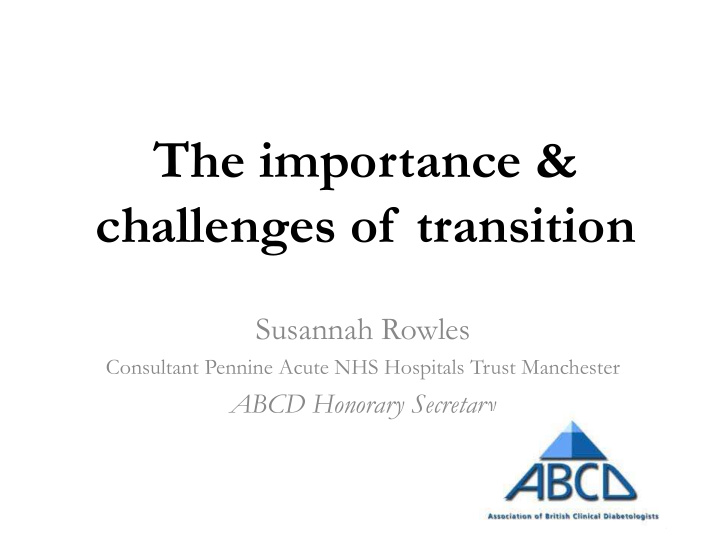



The importance & challenges of transition Susannah Rowles Consultant Pennine Acute NHS Hospitals Trust Manchester ABCD Honorary Secretary
Learning outcomes • Definition of transition • Why it matters • Why it’s so difficult • Some practical tips
Definition The period of time during which there is planned, purposeful and supported change in a young adult’s diabetes management from child orientated to adult orientated services, mirroring increasing independence and responsibility in other aspects of their life.” Adolescence…….developmental epoch which children become adults intellectually, physically, hormonally and socially
Hazard ratios of death with diabetes versus without diabetes 20-39 yrs 40-59y rs 60-79 yrs 2.54 2.17 1.91 male 3.76 2.54 2.53 female YHPHO 2008 Age of diagnosis matters: • If ∆ ≤ 10yrs old decrease in life expectancy by 16 yrs • If ∆ ≥ 16yrs old decrease in life expectancy by 10 yrs
14 th annual National Paediatric audit 2016/17 • Inequalities in treatment widening at both ends of the deprivation scale • Poorer outcomes associated with: white ethnicity, adolescence, female sex, living in deprived area • Rising rates of type 2 diabetes with greater incidence of micro & macrovascular disease than type 1 – 46% hypertension 20% albuminuria 5% abnormal eye screening 33% raised lipids 715 individuals 206/17 compared with 77 2015/16 DUK estimate 7,000 under the age of 25yrs
DKA Hypo
HORMONES/ PARENTS & HEREDITITY CAREERS SEARCH FOR “SELF” / INCREASING AUTONOMY SOCIAL/PEER PRESSURE DRUGS / ETOH ENVIRONMENT
TOP WORRIES Exams “Belonging” Body image Overscheduling Family conflict Relationships The future ………and diabetes
Why it is so hard . Or…… Good excuses for teenagers to give Neurobehavioral, morphological, neurochemical & pharmacological evidence of brain maturation
Executive prefrontal cortex functions Simultaneously Ability to considering Considering balance short multiple term rewards the future & streams of info making with long term that’s complex predictions goals & challenging Impulse control & Shifting/adjust delaying ing behaviour gratification Focusing Modulation when attention of intense situations emotion change Foreseeing & Inhibiting weighing inappropriate Organizing Forming possible behaviour thoughts & strategies & consequences /initiating problem planning o f behaviour appropriate solving behaviour
THE LIMBIC SYSTEM Involved in expression & motivation related to survival: • Fear, anger, flight / flight response • Eating, sex • Memory retrieval of events that have provoked a strong emotional response Adolescence are more likely to rely on their emotions to make decisions
VS
From here to maturity! Adolescent brain has greater capacity to: • Learn and create (neuroplasticity) • More prone to risk taking / impulsive behaviour • More prone to damage from drugs • Higher risk of addiction • Higher risk of mental illness Laying down of myelin - necessary for proper nerve insulation & effective neurocybernetics Excess grey matter is “pruned out”
Vital ingredients for myelinogenesis
Yin & Yang of nerve dialogue • Glutamatergic neurotranmission predominates – major excitatory neurotransmitter • GABA (gamma aminobutyric acid) neurotransmision is still under construction - major inhibitory neurotransmitter VS
Other important neurotransmitter changes in adolescence DOPAMINE ↓ SEROTONIN ↓ MELATONIN ↑ Movement control Mood alteration Circadian rhythms Emotional response Anxiety Sleep-wake cycle Ability to experience pain / Impulse control pleasure Arousal Mood swings Decreased impulse control Increased need for sleep Difficulty regulating emotion + oestrogen progesterone testosterone
What works? • Cultural continuity Minimising the differences between paed & adult culture • Disease management continuity A common purpose & plan shared between team members • Information continuity Approaches to info giving & materials consistent between paed / adult teams • Developmental continuity Proactively encouraging the young person to grow into a more independent adult • Flexible continuity Support responsive to individual needs Allen D et al 2010
Hints for the High HbA1c Transition & Young Person Patients • If the pt is on once daily lantus with suboptimal control consider swop to Tresiba • Is the pt on lantus twice a day, if so consider change to bd levimir twelve hours apart or to once daily Tresiba • If the pt does a lot of exercise and is on lantus or Tresiba consider swop to bd levimir twelve hours apart • Does the pt wait 10 minutes between injecting the rapid acting insulin and eating? If not, ask whether this habit can be changed or suggest swopping to fiasp unless pt has very high fat / protein meals • Ensure injection sites are rotated – have a look yourself don’t just ask • Ensure fresh needle is used for every injection
Hints for the High HbA1c Transition & Young Person Patients: • Never correct for hyperglycaemia after consuming alcohol & explain risk of severe hypos (often delayed) after XS ETOH • Remind female with type 1 diabetes that they are as fertile as people without diabetes so need to use robust contraception. Mention need for high dose folic acid and “as near perfect as possible” HbA1c control at time of conception. • Risk of passing on type 1 to your children if you are male is 1 in 17, if female and you have your child before you are 25 the risk in 1 in 25, if you’re > 25 when you have the child is 1 in 100 • Explore attitudes to use of “ libre ” devise & pump therapy • If aged > 17 yrs explain DAFNE course and offer DAFNE dates • Ask re plans for driving – offer DVLA info if appropriate • Ask on a scale of 1-10 how unhappy / happy the pt is, sign post to CAMS / Low level Ψ intervention if <6. If <4 address more fully.
“Parent -ectomy ” PARENT/PAEDIATRICIAN DIABETOLOGIST
Recommend
More recommend